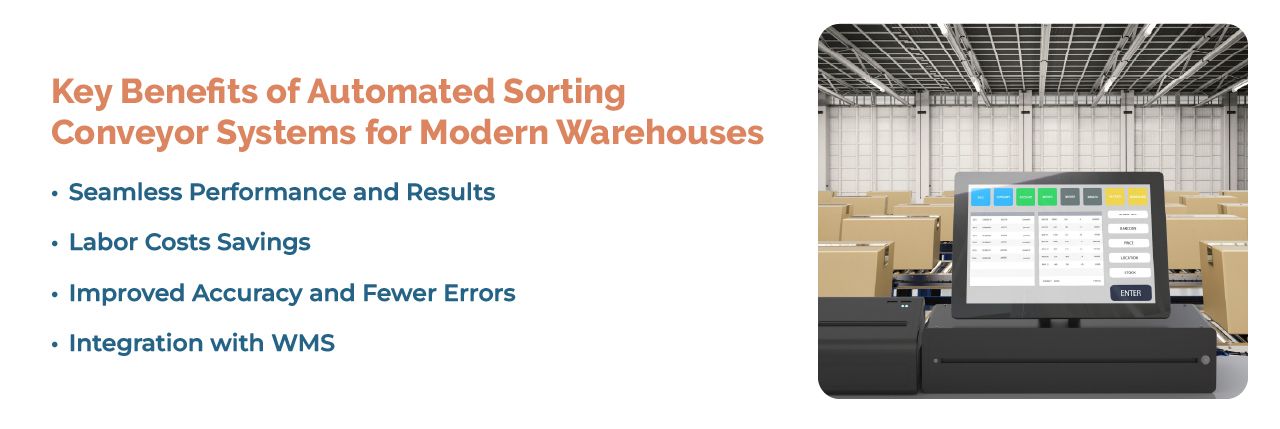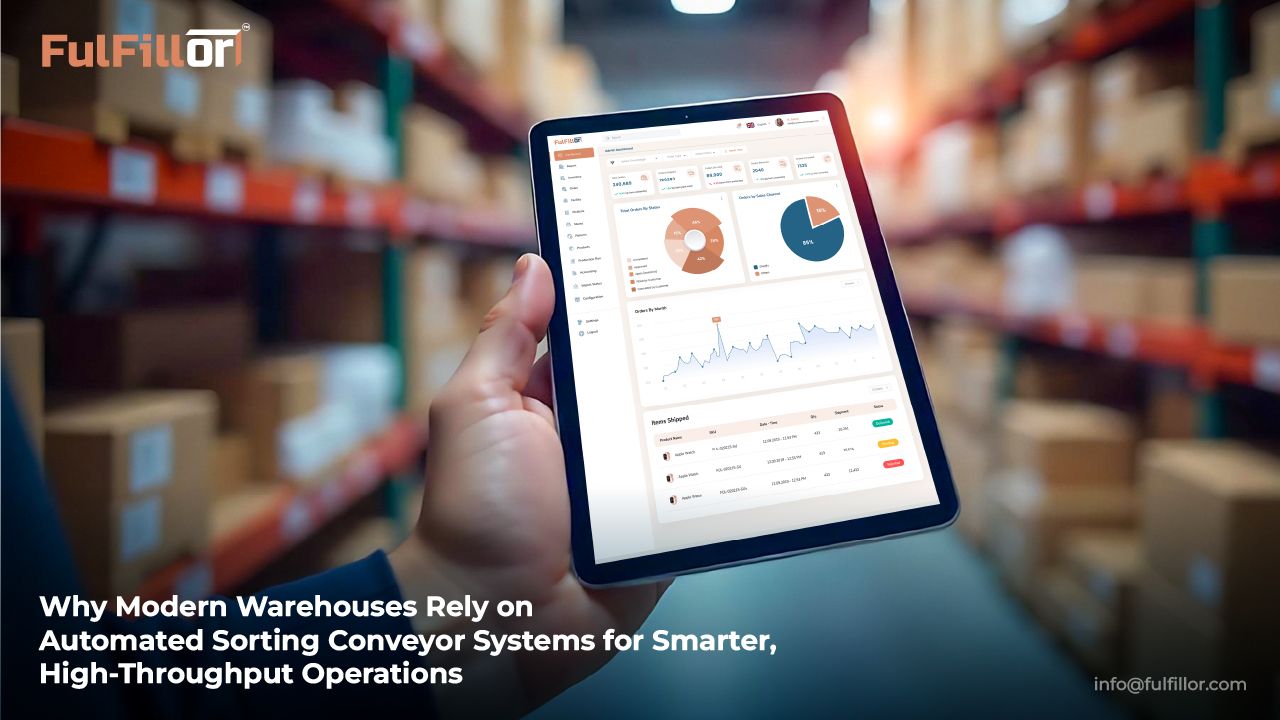Why Modern Warehouses Rely on Automated Sorting Conveyor Systems for Smarter, High-Throughput Operations
The Role of Smart WMS in Today’s Fulfillment Era
The modern warehouse is under constant pressure. With worldwide e-commerce sales rising above $6 trillion in 2024 and order volumes escalating, businesses have no margin for error or delay in fulfilling orders. In today’s logistics era, success equates to speed, accuracy, and flexibility. That’s why automated sorting conveyor systems and smart warehouse management software are becoming essential for efficient, high-throughput fulfillment operations. This is where the need for automatic sorting conveyor systems arises.
Warehouses, rather than being completely dependent on humans, are now increasingly relying on warehouse automation to keep pace. And one of the most promising technological solutions among them all is a conveyor capable of sorting, scanning, and directing items. At FulFillor, we see them not just as machines, but as the central hub of smarter warehouse operations with a strong Warehouse Management System (WMS) implementation alongside it.
Let’s take a look at why the automated sorting conveyor is an indispensable presence in the modern-day warehouse.
The Growing Role of Warehouse Automation and Sortation Systems
Automation in warehouses ranges from mechanical systems to digital ones. Physical automation encompasses conveyors, robotics, AS/RS (automated storage and retrieval systems), AGVs (automated guided vehicles), and AMRs. These technologies deliver goods rapidly and safely. Digital automation includes software such as a WMS like FulFillor, to organize inventory tracking and order routing, and performance analytics. These two forms of automation together minimize the strain on increasing labor costs, skills shortages, and the rapid-fire need for fast and accurate delivery.
What Are Automated Sorting Conveyor Systems and How They Work in Warehouses?
Automation in warehouses ranges from mechanical systems to digital ones. Physical automation encompasses automated sorting conveyor systems, robotics, AS/RS (automated storage and retrieval systems), AGVs (automated guided vehicles), and AMRs. These automated sortation conveyors form the backbone of warehouse throughput optimization, ensuring continuous material flow.
Digital automation includes software such as a smart Warehouse Management System (WMS) like FulFillor, to organize inventory tracking, real-time order routing, and performance analytics.
Together, these two forms of automation, physical sortation systems and digital warehouse control software, minimize the strain of increasing labor costs, skill shortages, and the need for fast and accurate delivery.
How Modern Conveyor Sortation Systems Work Inside a Smart Warehouse
The moment a product enters today's warehouse, it hits a conveyor sortation system that senses and identifies the item. Further, the Warehouse Management System (WMS) analyzes its destination based on order details, and the system’s sorters and diverters swiftly direct items accordingly. This automated sortation process eradicates bottlenecks, slashes processing times, and enables each product to move seamlessly from one stage to another a key aspect of warehouse workflow automation.
Such harmony between the conveyor system and WMS amplifies throughput, ensures real-time item tracking, and moves inventory correctly across zones with precision.
These integrated systems typically include motorized conveyors, advanced scanning technology, and automated material handling equipment, all working in sync to deliver high-speed, high-accuracy warehouse sortation.
Key Benefits of Automated Sorting Conveyor Systems for Modern Warehouses

1. Seamless Performance and Results
Automated sortation systems are a must-have in your warehouse process. Ongoing flow of goods and intelligent routing avoids bottlenecks that plague manual processes. The flow of inventory makes these systems go and keeps orders on the move from receipt to shipment, so that larger quantities can be processed with measurable regularity in warehouses.
2. Labor Costs Savings
By replacing the use of manual labor with automation, it delivers measurable savings in labor costs. The system takes care of routine functions, freeing time of your staff to concentrate on more value-added tasks like quality control and management. The change cuts hiring and training costs, as well as boosts worker satisfaction. Several warehouses have reported quantifiable labor cost savings only one year after implementation.
3. Improved Accuracy and Fewer Errors
Accuracy dramatically enhances when sophisticated sensors and scanners monitor the products as they move through every stage of the process. When each can is consistently tagged and directed, the likelihood of everyday mistakes like mislabeling, lost stock, or incorrect shipping decreases significantly. This increased accuracy also leads to fewer returns and better supply chain trustworthiness.
4. Integration with WMS
The real power of automated conveyors comes into play when it is combined with a warehouse management system (WMS). Every scan instantaneously updates inventory logs, order details, and shipping information. Enterprise-level solutions, such as FulFillor’s WMS, aggregate scan data into a single dashboard, providing instant visibility of stock while enabling quick replenishment and empowering real-time business decisions to continuously improve operations.
How Automated Conveyors and Robotics Power the Future of Warehouse Automation
Robotic conveyor sorting systems do not work in isolation. They work with a variety of other warehouse automation systems that all collaborate to optimize the product flow.
The key technologies in this ecosystem include:
- Pick-and-pack robotics.
- AS/RS (Automated Storage and Retrieval Systems) for high-bay or narrow-aisle storage.
- AGVs and AMRs for flexible transport of materials.
- Good-To-Person (GTP) systems that deliver items directly to the operator.
When integrated with a warehouse management system (WMS) like our next-gen FulFillor, these technologies form a synchronized operation where inventory tracking, order management, and physical automation work in harmony.
Conclusion: Smarter Warehouses with FulFillor WMS & Automated Sorting Systems
Automated sorting conveyor systems are transforming warehouse operations, allowing manufacturers and distributors to reduce human-oriented errors and costly delays in order fulfillment, enhancing productivity. When you integrate such solutions with a modern WMS like FulFillor, warehouses gain additional advantages, including real-time visibility, minimal costs, and optimized fulfillment. Our comprehensive, feature-rich WMS has been designed to deliver this fully integrated, best-in-class digital control, and enable you to not only keep up with market demands but set the benchmark.
Ready to move your operations into the future? Discover how Fulfillor's Warehouse Management System (WMS) can help you integrate automated sorting conveyor systems and achieve smarter operations. Book a demo with FulFillor’s WMS experts today and power your path to smarter, more profitable warehouse automation, and help warehouses achieve end-to-end order fulfillment automation.
FAQs: Automated Sorting Conveyor Systems & Warehouse Automation
- How do automated sorting conveyor systems improve warehouse operations?
- Automated sorting conveyor systems streamline warehouse workflows by accelerating the sorting process, reducing human error, and increasing order accuracy. When connected to a smart Warehouse Management System (WMS) like FulFillor, they ensure real-time inventory tracking, faster order routing, and improved overall warehouse productivity.
- Can automated conveyors integrate with other warehouse automation systems?
- Yes. They integrate easily with robotics, AS/RS (Automated Storage and Retrieval Systems), AGVs (Automated Guided Vehicles), and AMRs (Autonomous Mobile Robots). This creates a fully synchronized warehouse automation ecosystem, where conveyors, robotics, and WMS software work together to optimize material handling and order fulfillment.
- Are automated sorting conveyors suitable for scaling warehouse operations?
- Absolutely. Automated sortation conveyors are highly scalable and flexible, making them ideal for warehouses facing seasonal demand peaks or rapid eCommerce growth.
- How do automated sorting conveyors support eCommerce and 3PL fulfillment?
- These systems are purpose-built for high-volume eCommerce and third-party logistics (3PL) operations. They enable rapid order sorting, accurate SKU tracking, and fast dispatch, ensuring same-day or next-day delivery capabilities for online sellers. Combined with a cloud-based WMS, they provide real-time visibility and performance analytics across the fulfillment network.

